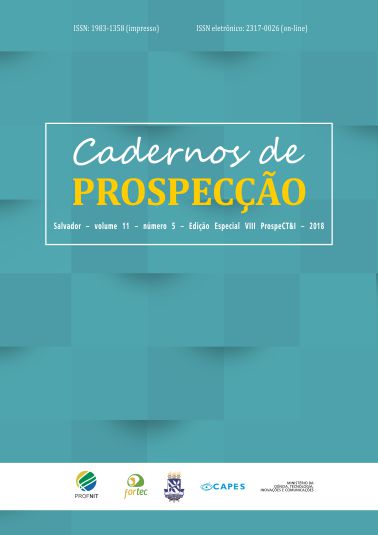Prospecção Tecnológica de Patentes Relativas a Proteases na Produção de Queijos
DOI:
https://doi.org/10.9771/cp.v11i5.27619Palavras-chave:
Protease, Produção de queijo, Patente.Resumo
As proteases são importantes insumos para o mercado mundial de enzimas, destacando-se, dentre outras aplicações, no processo de coagulação do leite para a produção de queijos. Diante disso, este trabalho objetivou avaliar a inovação no uso de proteases na indústria de alimentos, especialmente na fabricação de queijos, por meio da análise de patentes nas bases de dados Espacenet e do Instituto Nacional de Propriedade Industrial (INPI). Foram recuperadas 3.402 (Espacenete INPI) patentes com proteases, sendo 93 com proteases vegetais. Uma busca mais específica e relacionada à fabricação de queijos, resultou 19 patentes com proteases (Espacenet e INPI); e três, com proteases vegetais (Espacenet). Em ambos os cenários, os principais investidores identificados foram empresas, e o Brasil mostrou-se praticamente ausente nessa área de inovação. Os resultados demonstraram, portanto, que a inovação em proteases vegetais para fabricação de queijos é uma rota interessante para novas pesquisas e desenvolvimento tecnológico.
Downloads
Referências
ABU-ALRUZ, K. et al. Effect of Proteases on Meltability and Stretchability of Nabulsi Cheese. American Journal of Agricultural and Biological Sciences, v. 4, n. 3, p. 173-178, 2009.
CABALLERO, P.; GÓMEZ, M.; ROSELL, C. Improvement of dough rheology, bread quality and bread shelf-life by enzymes combination. Journal of Food Engineering, v. 81, n. 1, p. 42-53, 2007.
CHOI, J. M.; HAN, S. S.; KIM, H. S. Industrial applications of enzyme biocatalysis: current status and future aspects. Biotechnology Advances, v. 33, n. 7, p. 1.443-1.454, 2015.
CRABBE, M. J. C. Rennets: general and molecular aspects. Cheese: Chemistry, physics and microbiology, v. 1, p. 19-45, 2004.
DAIHA, K. et al. Enzyme technology in Brazil: trade balance and research community. Brazilian Journal of Science and Technology, v. 3, n. 17, 2016.
DEWAN, S. S. Global Markets for Enzymes in Industrial Applications. Report ID: BIO030J. [S.l.]: BBC Research, 2017. Disponível em: <https://www.bccresearch.com/market-research/biotechnology/enzymes-industrial-applications-report-bio030j.html>. Acesso em: 13 nov. 2017.
FEDERAÇÃO DAS INDÚSTRIAS DO ESTADO DO CEARÁ. Rotas Estratégicas Setoriais: Núcleo de Economia e Estratégia do Sistema FIEC. 2016. Disponível em: <http://www1.sfiec.org.br/nucleodeeconomia/programas/92187/rotas-estrategicas-setoriais>. Acesso em: 15 nov. 2017.
GLOBAL MARKET INSIGHTS. Enzymes Market, 2016 – 2024. Report ID: GMI743. [S.l.]: Global Market Insights, 2017. Disponível em: <https://www.gminsights.com/industry-analysis/enzymes-market>. Acesso em: 17 nov. 2017.
HONG, S. The magic of patent information. World Intellectual Property Organization, [S.l.], 24 nov. 2004. Disponível em: <http://www.wipo.int/export/sites/www/sme/en/documents/pdf/patent_information.pdf>. Acesso em: 15 nov. 2017.
HU, A. G.; JEFFERSON, G. H. A great wall of patents: what is behind China's recent patent explosion? Journal of Development Economics, v. 90, n. 1, p. 57-68, 2009.
LI, X. Behind the recent surge of Chinese patenting: an institutional view. Research Policy, v. 41, n. 1, p. 236-249, 2012.
MEMBER states of the European Patent Organisation. [2018]. Disponível em: <https://www.epo.org/about-us/foundation/member-states.html>. Acesso em: 4 nov. 2017.
NELSON, D.; COX, M. Lehninger principles of biochemistry. 6. ed. New York: W. H. Freeman, 2013.
NOVOZYMES. Novozymes inaugurates R&D laboratories in Brazil. 2011. Disponível em: <https://www.novozymes.com/news/news-archive/2011/11/novozymes-inaugurates-rd-laboratories-in-brazil->. Acesso em: 16 nov. 2017.
O'CONNOR, C. Traditional cheesemaking manual. Addis Ababa, Etiopia: International Livestock Centre for Africa, 1993.
PANDEY, A. et al. Current developments in biotechnology and bioengineering: food and beverages industry. 1. ed. [S.l.]: Elsevier, 2017. p. 119-120.
PATEL, A. K.; SINGHANIA, R. R.; PANDEY, A. Novel enzymatic processes applied to the food industry. Current Opinion in Food Science, v. 7, p. 64-72, 2016.
RAWLINGS, N. et al. The MEROPS database of proteolytic enzymes, their substrates and inhibitors in 2017 and a comparison with peptidases in the PANTHER database. Nucleic Acids Research, v. 46, n. D1, p. D624-D632, 2018.
ROCHA, I. S. et al. Estudo prospectivo relativo a depósitos de patentes relacionadas às enzimas peptidases. Cadernos de Prospecção, Salvador, v. 8, n. 1, p. 123-132, 2015.
SHAH, M. A.; MIR, S. A.; PARAY, M. A. Plant proteases as milk-clotting enzymes in cheesemaking: a review. Dairy Science & Technology, v. 94, n. 1, p. 5-16, 2014.
TEIXEIRA, J. et al. Patentes, calcanhar de Aquiles. Em Discussão: Os principais debates do Senado Federal, Brasília, DF, n. 12, p. 61, 2012.
ZHU, X. et al. Actinidin pretreatment and sous vide cooking of beef brisket: Effects on meat microstructure, texture and in vitro protein digestibility. Meat Science, v. 145, p. 256-265, 2018.
WORLD INTELLECTUAL PROPERTY ORGANIZATION. PCT FAQs. 2017. Disponível em: <http://www.wipo.int/pct/en/faqs/faqs.html>. Acesso em: 4 nov. 2017.
Downloads
Publicado
Como Citar
Edição
Seção
Licença
Copyright (c) 2018 Cadernos de Prospecção

Este trabalho está licenciado sob uma licença Creative Commons Attribution-NonCommercial 4.0 International License.
O autor declara que: - Todos os autores foram nomeados. - Está submetendo o manuscrito com o consentimento dos outros autores. - Caso o trabalho submetido tiver sido contratado por algum empregador, tem o consentimento do referido empregador. - Os autores estão cientes de que é condição de publicação que os manuscritos submetidos a esta revista não tenham sido publicados anteriormente e não sejam submetidos ou publicados simultaneamente em outro periódico sem prévia autorização do Conselho Editorial. - Os autores concordam que o seu artigo ou parte dele possa ser distribuído e/ou reproduzido por qualquer forma, incluindo traduções, desde que sejam citados de modo completo esta revista e os autores do manuscrito. - Revista Cadernos de Prospecção está licenciado com uma Licença Creative Commons Attribution 4.0. Esta licença permite que outros remixem, adaptem e criem a partir do seu trabalho para fins não comerciais, e embora os novos trabalhos tenham de lhe atribuir o devido crédito e não possam ser usados para fins comerciais, os usuários não têm de licenciar esses trabalhos derivados sob os mesmos termos.
Este obra está licenciado com uma Licença Creative Commons Atribuição 4.0 Internacional.








